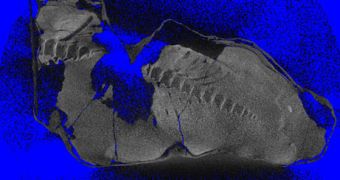There are mummies which can be older than those of the ancient pharaohs. Some even older than 65 Ma. An amazingly preserved "dinosaur mummy", containing a lot of tissues and bones inside skin wrapping, is being brought to light in North Dakota's state museum. Dakota is an Edmontosaurus, one of the largest duckbilled dinosaurs and was discovered in southwestern North Dakota in 2004. The fossilized skin of the 67-Ma-old dino is hard as iron.
"This is the closest many people will ever get to seeing what large parts of a dinosaur actually looked like, in the flesh," said co-researcher Phillip Manning, a paleontologist at Manchester University in England.
Animal soft tissue usually decomposes rapidly after death, but Dakota could have been covered rapidly by sediments so that its skin was preserved.
"The process of decay was overtaken by that of fossilization, preserving many of the soft-tissue structures," Manning said. The fossil was first encountered by Tyler Lyson, a 25-year-old doctoral paleontology student at Yale University, on his uncle's ranch in the Badlands, in 1999. In 2004, he began to unearth the fossil and soon realized its scientific value.
World's largest CT scanner, operated by the Boeing Co. in California and employed for investigating space shuttle parts, came with a detailed image of what was inside the block of sandstone.
"This is the fourth dinosaur mummy that's ever been found in the world of any significance. It may turn out to be one of the best mummies, because of the quality of the skin that we're finding and the extent of the skin that's on the specimen," said Stephen Begin, a Michigan consultant on the project.
"It will take a year, maybe more, to uncover it. The main part of the fossil is in two parts, weighing a total of nearly 5 tons (4.54 metric tons). The skeleton itself is kind of curled up. The actual length would be about 30 feet (10 m), from about the tip of its tail to the tip of its nose," said state paleontologist John Hoganson, of the North Dakota Geological Survey. The Badlands of western North Dakota represent a heaven for the paleontologists, due to the heavy erosion caused by weather over time.
"Other treasures likely are waiting to be unearthed. It's one of the few places in the world where you can actually see the boundary line where the dinosaurs became extinct. In the Badlands, this layer is exposed in certain places," said Hoganson.
The mummified dinosaur weighed some 30 tons (as much as 6 African elephants), but CT scanning determined that the muscle mass located between the bone and skin tail was 25% larger than it had previously been thought. Based on this information, a computer model determined the speed of the huge beast. This means that the duck-billed dinosaurs could outrun a T. rex.
The mummified dinosaur could have run with 28 mi (45 km) per hour, while Tyrannosaurus rex with just 20 mi (32 km) per hour (anyhow, this is faster than a human). Indeed, duck-billed dinosaurs were preyed by T. rex, and as they did not have horns or armors, speed being their prime defense.

 14 DAY TRIAL //
14 DAY TRIAL //